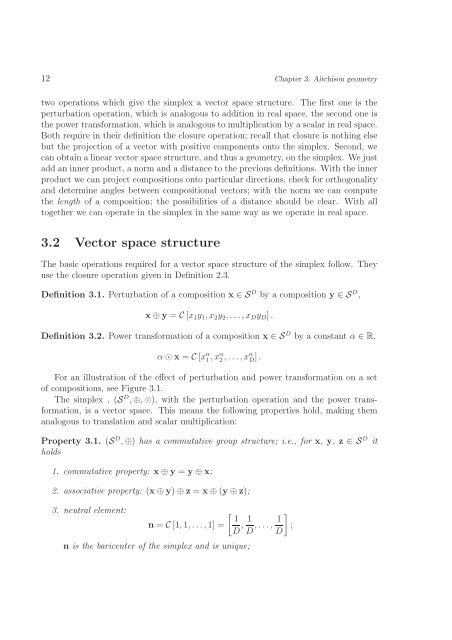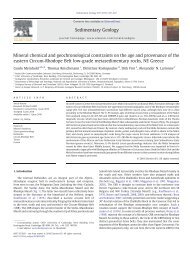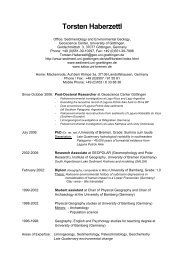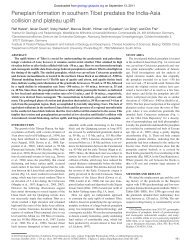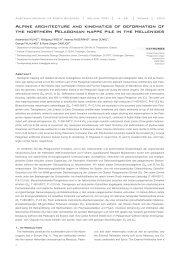Lecture Notes on Compositional Data Analysis - Sedimentology ...
Lecture Notes on Compositional Data Analysis - Sedimentology ...
Lecture Notes on Compositional Data Analysis - Sedimentology ...
Create successful ePaper yourself
Turn your PDF publications into a flip-book with our unique Google optimized e-Paper software.
12 Chapter 3. Aitchis<strong>on</strong> geometry<br />
two operati<strong>on</strong>s which give the simplex a vector space structure. The first <strong>on</strong>e is the<br />
perturbati<strong>on</strong> operati<strong>on</strong>, which is analogous to additi<strong>on</strong> in real space, the sec<strong>on</strong>d <strong>on</strong>e is<br />
the power transformati<strong>on</strong>, which is analogous to multiplicati<strong>on</strong> by a scalar in real space.<br />
Both require in their definiti<strong>on</strong> the closure operati<strong>on</strong>; recall that closure is nothing else<br />
but the projecti<strong>on</strong> of a vector with positive comp<strong>on</strong>ents <strong>on</strong>to the simplex. Sec<strong>on</strong>d, we<br />
can obtain a linear vector space structure, and thus a geometry, <strong>on</strong> the simplex. We just<br />
add an inner product, a norm and a distance to the previous definiti<strong>on</strong>s. With the inner<br />
product we can project compositi<strong>on</strong>s <strong>on</strong>to particular directi<strong>on</strong>s, check for orthog<strong>on</strong>ality<br />
and determine angles between compositi<strong>on</strong>al vectors; with the norm we can compute<br />
the length of a compositi<strong>on</strong>; the possibilities of a distance should be clear. With all<br />
together we can operate in the simplex in the same way as we operate in real space.<br />
3.2 Vector space structure<br />
The basic operati<strong>on</strong>s required for a vector space structure of the simplex follow. They<br />
use the closure operati<strong>on</strong> given in Definiti<strong>on</strong> 2.3.<br />
Definiti<strong>on</strong> 3.1. Perturbati<strong>on</strong> of a compositi<strong>on</strong> x ∈ S D by a compositi<strong>on</strong> y ∈ S D ,<br />
x ⊕ y = C [x 1 y 1 , x 2 y 2 , . . .,x D y D ] .<br />
Definiti<strong>on</strong> 3.2. Power transformati<strong>on</strong> of a compositi<strong>on</strong> x ∈ S D by a c<strong>on</strong>stant α ∈ R,<br />
α ⊙ x = C [x α 1 , xα 2 , . . .,xα D ].<br />
For an illustrati<strong>on</strong> of the effect of perturbati<strong>on</strong> and power transformati<strong>on</strong> <strong>on</strong> a set<br />
of compositi<strong>on</strong>s, see Figure 3.1.<br />
The simplex , (S D , ⊕, ⊙), with the perturbati<strong>on</strong> operati<strong>on</strong> and the power transformati<strong>on</strong>,<br />
is a vector space. This means the following properties hold, making them<br />
analogous to translati<strong>on</strong> and scalar multiplicati<strong>on</strong>:<br />
Property 3.1. (S D , ⊕) has a commutative group structure; i.e., for x, y, z ∈ S D it<br />
holds<br />
1. commutative property: x ⊕ y = y ⊕ x;<br />
2. associative property: (x ⊕ y) ⊕ z = x ⊕ (y ⊕ z);<br />
3. neutral element:<br />
n = C [1, 1, . . ., 1] =<br />
[ 1<br />
D , 1 D , . . ., 1 D]<br />
;<br />
n is the baricenter of the simplex and is unique;


